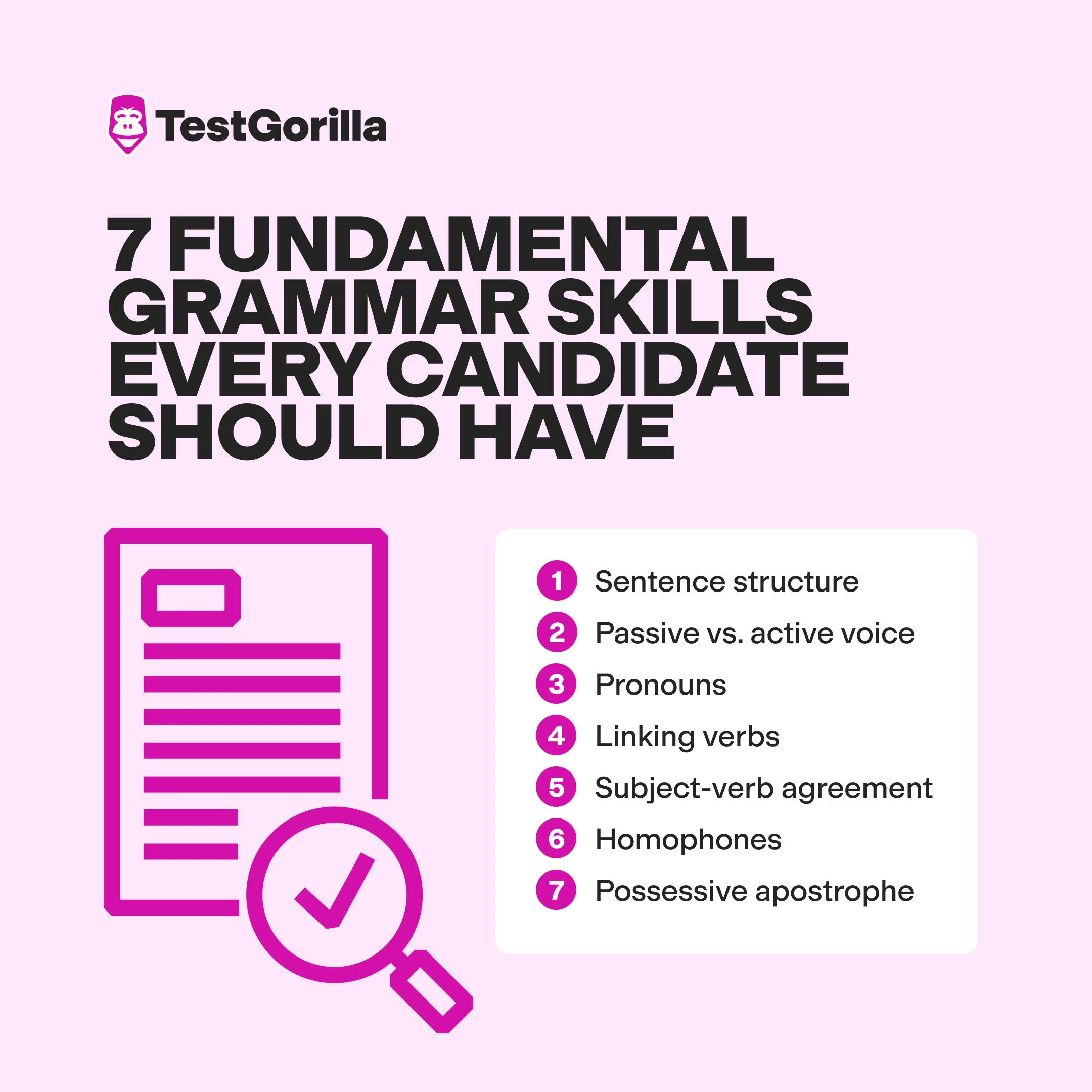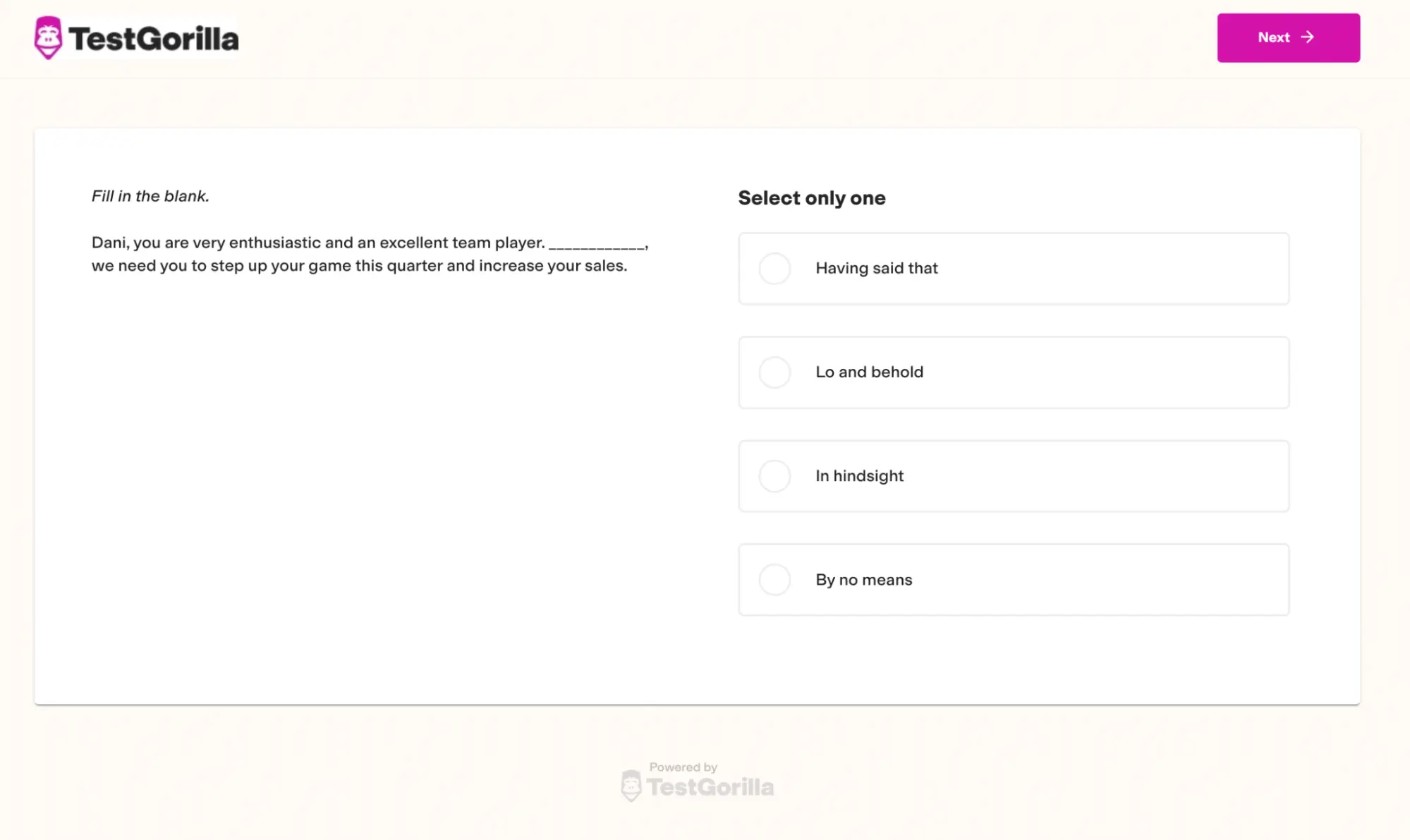Hire smarter with candidate assessment software
Nothing ruins a professional first impression faster than poor grammar skills. After all, a typo-filled email shows potential clients that you don’t value them enough to pay attention.
Finding great communicators with crisp grammar skills ensures that your company nails every form of communication, from day-to-day emails to high-stakes sales presentations.
In this article, we explain grammar skills, what to look for in candidates, and how to use talent assessments to help with the screening process.
Table of contents
- What is a grammar skills assessment?
- Why are grammar skills important in the workplace?
- 7 fundamental grammar skills and competencies
- How to assess grammar skills and traits with talent assessments
- When and how to test for grammar skills using talent assessments
- How to develop grammar skills
- Use TestGorilla to find employees with the right grammar skills
- Grammar skills assessment FAQs
What is a grammar skills assessment?
A grammar skills assessment evaluates a job candidate’s communication skills and ability to apply grammar rules in a certain language. Grammar assessments evaluate candidates on specific skills like correct use of tenses, word types (like adjectives or adverbs), punctuation, passive vs. active voice, and idioms.
The level of grammar skills required of a candidate depends on the role. For a copywriter or communications director, mastery of the details matters. Writing an entire product guide in the passive voice or a mission statement riddled with typos could be embarrassing.
For your average employee sending emails, mastering the basics of grammar, like parts of speech, is sufficient.
Grammar skills assessments typically employ a range of questions, including:
Multiple choice
Fill-in-the-blanks
Composition tasks (requiring candidates to write sentences or paragraphs correctly)
Corrections
Sentence diagramming (explaining how each part of the sentence works)
Why are grammar skills important in the workplace?
Grammar skills are important in the workplace because they facilitate communication and enhance your reputation. Whether in interoffice emails, client communications, quarterly reports, or social media posts, your team’s grammar skills reflect your organization's professionalism.
Although this is crucial for roles where writing or proofreading is a core function, like PR officers, copywriters, and editors, don’t underestimate the grammatical skills needed by your average line worker.
Your employees also reap the benefits of being strong communicators. Research shows that professionals who make fewer grammatical errors earn more promotions and higher positions.
Here’s an overview of the benefits:
Make a good first impression
Error-free writing is essential for making a good first impression. Written communication is often the first contact a client, customer, partner, or supplier has with your business. Good grammar reassures recipients that they can feel confident working with your business.
Ensure effective communication
With better grammar and syntax skills, employees communicate effectively, clearly, and precisely. Poor grammar might result in miscommunications, misunderstandings, and delays.
Reflect a level of professionalism
Your employees reflect your company brand and values, so their writing skills must uphold professionalism, which helps you build your brand and credibility.
Save time and money
Employees with poor grammatical skills require colleagues to oversee or proofread their written work before it’s sent out, which can be time-consuming and unnecessarily distracting.
Indicate attention to detail
Employees with strong grammar skills have a high level of attention to detail, which may indicate how they approach their work more broadly. Correct grammar usage suggests a candidate is conscientious and more likely to produce high-quality work.
The best insights on HR and recruitment, delivered to your inbox.
Biweekly updates. No spam. Unsubscribe any time.
7 fundamental grammar skills and competencies
Learning the most important grammar skills helps your workplace benefit from concise communication, less uncertainty, and an excellent professional reputation.
These seven grammar skills are an easily quantifiable foundation for strong communication skills in English speakers.
1. Sentence structure
To communicate effectively in the workplace, employees should understand the different elements of a sentence and how to use them in the correct order. They include verbs, adverbs, adjectives, nouns, prepositions, subjects, objects, and clauses.
Employees may need to know how to write simple, compound, complex, or compound-complex sentences, depending on their role. Understanding these foundations helps employees communicate effectively.
2. Passive vs. active voice
When using the active voice, the sentence's subject performs an action. In comparison, the subject receives the action when using the passive voice. For example, “ABC Company prioritizes customer service and value” uses the active voice, whereas “Customer service and value is prioritized by ABC Company” uses the passive voice.
Most of the time, you must use the active voice in business writing. It’s more direct and clear, making writing more engaging to the reader.
3. Pronouns
Pronouns are words that can replace proper nouns – for example, “I,” “you,” “he,” “she,” and “they.”
Using pronouns makes writing more concise and natural-sounding. For example, rather than saying, “Vera is our marketing director. Vera is passionate about communication”, you can say, “Vera is our marketing director. She is passionate about communicating with customers.”
4. Linking verbs
Regular and irregular verbs usually describe an action in the sentence. However, linking verbs describe the state of the subject.
“Be,” “seem,” and “look” are common linking verbs. Examples include “She is the chief executive officer of the company” and “The market looks like it is moving in an upward direction.”
Grammar rules state that linking verbs cannot be followed by a full clause. Understanding the rules around linking clauses means candidates can produce more complex, descriptive sentences.
5. Subject-verb agreement
Verbs must agree with the number, person, or gender of the sentence's subject. For example, in English, the verb “be” in the present tense changes depending on the subject – ”I am,” “you are,” or “she is.”
Employees need to know and apply the correct subject-verb agreement rules for effective and error-free communication.
6. Homophones
Homophones are words that are pronounced the same but spelled differently. Some common examples when you learn English include:
“Your,” “you’re”
“There,” “they’re,” and “their”
“Loose” and “lose”
“Affect” and “effect”
“Compliment” and “complement”
Using the wrong homophone in written communication can reflect poorly on your business, so you must test candidates’ awareness of them.
7. Possessive apostrophe
The placement of an apostrophe can change the meaning of a sentence. For example, “all of the candidate’s results were strong” refers to a single candidate, while “all of the candidates’ results were strong” refers to multiple candidates.
Understanding the correct placement of a possessive apostrophe is important for clarity and avoiding misunderstandings.
How to assess grammar skills and traits with talent assessments
Core grammar skill assessments are a great tool for building a strong communication team.
By relying on a dependable skills assessment platform rather than a one-off writing sample or your gut feeling about the candidate, you can ensure a replicable and bias-free screening funnel to recruit the best candidates.
Choose your grammatical tests
Wondering how to assess grammar skills? Start by creating a battery of grammatical assessments to identify candidates who are strong communicators.
Our platform lets you build your own, or you can use our prebuilt grammatical tests below.
Grammar and communication skills | Test |
Attention to detail | Attention to Detail test |
Communication | Communication Skills test |
Role-specific writing | Legal Research and Writing test and SEO Copywriting test |
Language-specific grammar | Grammar assessments (like the English C2 test) |
1. Attention to detail
Candidates with excellent grammar skills possess sharp attention to detail, which helps them apply the right rules to all possible scenarios and instantly spot common grammar mistakes.
You can use TestGorilla’s Attention to Detail (Textual) test to see how well candidates can check the consistency of information and compare differences between statements in an unbiased grammatical assessment.
2. Communication skills
Strong grammar skills enhance candidates’ overall written communication. Our Communication Skills test is useful for gaining a picture of candidates’ broader professional communication abilities and styles.
Using questions like the one below, this test provides further insights into your candidates’ written communication, including their grammar abilities and professional communication etiquette.
Click here to see more preview questions from this test.
3. Role-specific writing tests
Communication skills vary depending on the role, so testing your candidates’ writing and grammar skills in a specific context is important.
The Legal Research and Writing test and SEO Copywriting test offer insights into candidates’ written communication skills in these roles.
Build a team of concise communicators with TestGorilla
Starting with TestGorilla is simple and 100% free. Discover how TestGorilla’s grammar skills tests can uncover top talent.
4. Language-specific grammar examinations
TestGorilla offers a range of grammar and vocabulary tests that follow the Common European Framework of Reference (CEFR) for languages. When you sign up for our language-specific tests you are able to evaluate candidates across 13 languages.
Our language-specific assessments cover intermediate (B1) to proficient (C2) skills for various languages, including:
Spanish
Japanese
Arabic
French
German
English
Dutch
Russian
Norwegian
Swedish
For example, the English C2 grammar test uses questions like the one below to gauge a candidate’s mastery of English grammar skills.
When and how to test for grammar skills using talent assessments
Always administer grammar skills tests at the beginning of the screening process, before the interview stage, and right after receiving applications.
Pre-employment testing is a valuable tool you can use to assess grammar. Our platform gives you the flexibility to use in-depth testing for copywriters or editors and a less in-depth and role-appropriate battery of tests for other workers.
You should create a baseline for grammar skills performance like this:
Level of responsibility | Recommended assessments |
Primary responsibility: copywriters, editors, or PR professionals | In-depth assessment of technical grammar skills, like our English C1 (Advanced) test. |
Peripheral responsibility: sales representatives, customer service agents, and office administrators | Basic assessment of common grammar skills, like our English B2 (Upper Intermediate) test. |
For instance, Contentoo uses skills testing to identify top candidates against its multi-year baseline. Copywriters and editors complete a series of advanced grammar tests, while customer service staff are held to a more basic standard.
Alternatively, you can use our baseline for a zero-stress implementation, which shows you how your candidates perform on your grammar assessment tests versus your current employees.
Switch to skills testing to cut your time-to-hire
Leading companies use TestGorilla to hire better communicators. Explore TestGorilla’s skills tests and shortlisting tools.
How to develop grammar skills
Whether you want to grow grammar skills for yourself or your team, you follow the same best practices:
Read widely: You reinforce proper grammar rules by experiencing the language and adopting a learner’s mindset. As an added benefit, your fluency and vocabulary grow alongside your grammar skills – even if you’re already a native speaker.
Practice writing: Start by writing, and then review what you wrote. Online tools like grammar checkers, interactive grammar games, and grammar exercises help you identify weak spots. Trusty grammar books also serve as solid references.
Listen for feedback: Invite your colleagues to help you improve your grammar skills, and then take their feedback seriously. If your manager points out that you use run-on sentences, learn to split your sentences into short ideas.
Use TestGorilla to find employees with the right grammar skills
Testing grammar skills is a great way to hire candidates with stellar communication skills and great attention to detail. In this article, we’ve shown that you can save time establishing candidates’ grammar skills by using skills testing to screen candidates.
From basic grammar skills to deep technical mastery, our platform makes it easy to assess skills in minutes.
Start with a live demo to see how painless hiring the best candidates is with a skills-based approach.
When you’re ready to take screening to the next level and build a strong team of grammar-proficient employees, sign up for a Free forever plan today.
Grammar skills assessment FAQs
Here are answers to three of the most commonly asked questions about grammar skills.
How do you assess grammar?
Assess the correct use of verb tenses
Evaluate the use of punctuation marks, such as commas and semicolons
Rate the understanding and usage of the active versus passive voice
Measure the understanding of idioms that are used in the workplace
Determine knowledge of and usage of word types, like verbs, adverbs, adjectives, conjunctions, and modifiers
What are the five approaches to grammar assessment?
Common European Framework of Reference for Languages (CEFR) approach
Performance assessment approach
Discrete point approach, which focuses on testing individual components of grammar skills to understand the applicant’s overall understanding
Second language (L2) approach for native speakers of languages other than English
Development approach
What is the best way to test grammar?
Multiple choice questions
Fill-in-the-blank questions to measure English language skills and technical grammar rules
Composition tasks to select the best additions to a prewritten text
Corrections to existing written documents
Sentence diagramming for an in-depth analysis of practical grammar skills
You've scrolled this far
Why not try TestGorilla for free, and see what happens when you put skills first.





















